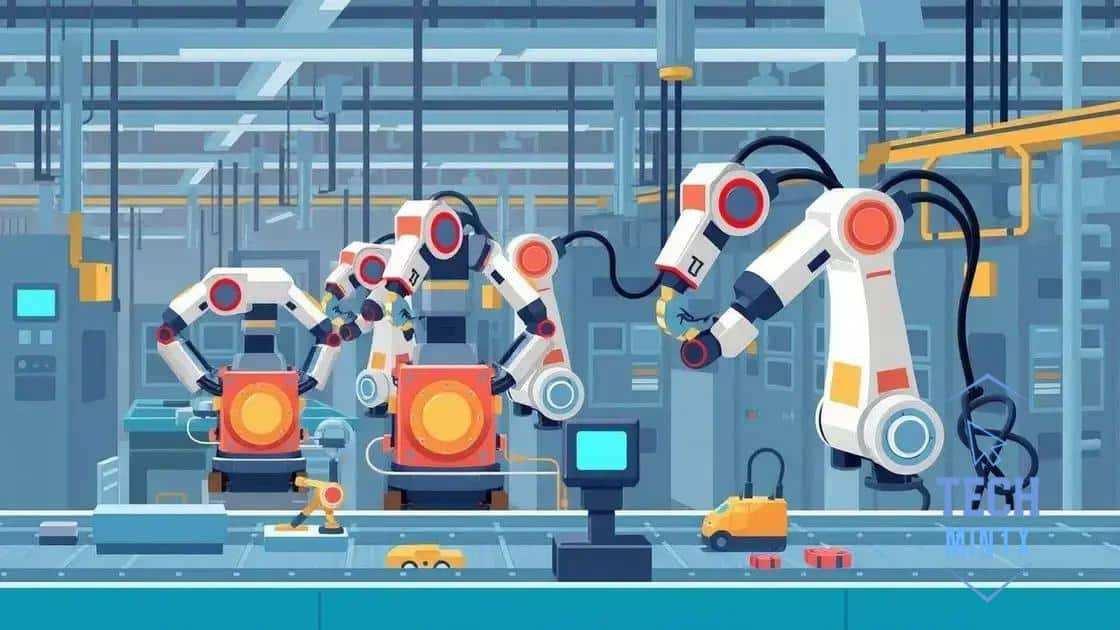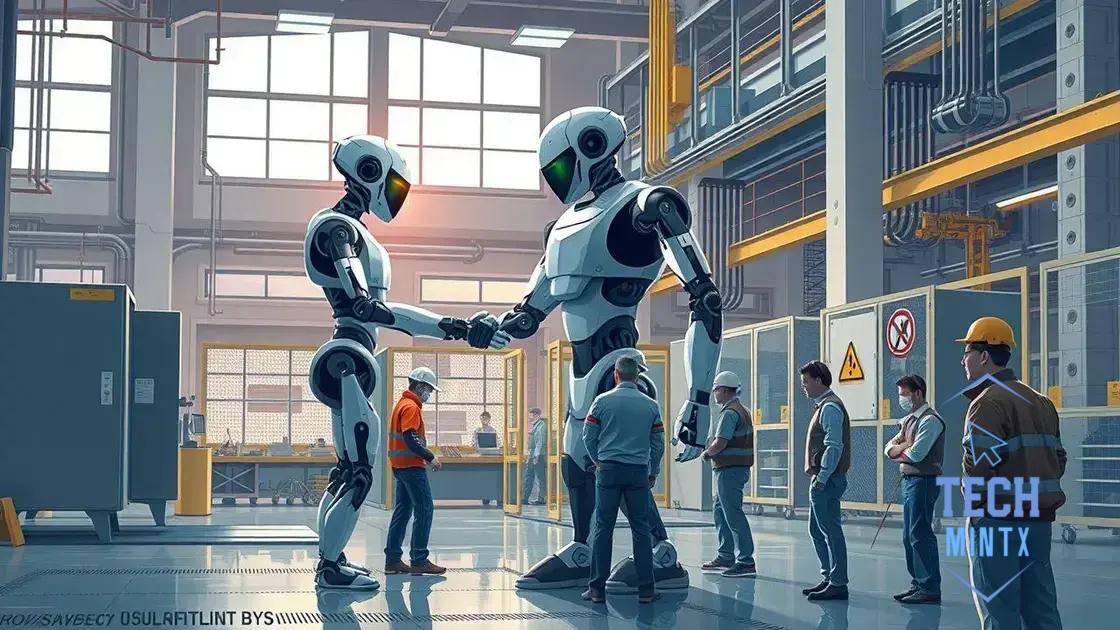Smart robotics reshape logistics and manufacturing

Smart robotics reshape logistics and manufacturing by enhancing efficiency, reducing costs, and enabling faster response times through automation and intelligent technologies.
Smart robotics reshape logistics and manufacturing in ways we never imagined. Have you considered how these advancements could change the way industries operate? Let’s dive into their transformative impact.
Understanding smart robotics in modern logistics
Understanding smart robotics in modern logistics is essential for grasping how industries enhance their operations. Robotics is not just about automation; it’s about intelligent systems that empower human workers.
What is Smart Robotics?
Smart robotics refers to robots that can perform tasks autonomously, seamlessly integrating with existing systems. These advanced machines are equipped with sensors, artificial intelligence, and machine learning capabilities, allowing them to adapt to various scenarios.
Benefits of Smart Robotics
Adopting smart robotics brings numerous advantages to logistics:
- Increased efficiency through faster processes.
- Reduced labor costs by automating repetitive tasks.
- Improved accuracy, minimizing errors in inventory management.
- Enhanced safety by taking over hazardous tasks.
Implementing these systems not only boosts productivity but also allows human workers to focus on more complex tasks. This shift creates a more dynamic work environment.
Real-world Applications
Companies around the world have begun integrating smart robotics into their logistics operations:
- Robot delivery systems, navigating autonomously to transport goods.
- Automated warehousing solutions, streamlining inventory management.
- Smart forklifts, optimizing loading and unloading processes.
These applications demonstrate the transformative impact smart robotics can have on logistics practices. As businesses continue to explore these technologies, their roles are likely to expand and evolve.
Smart robotics not only boost efficiency but also significantly enhance customer satisfaction. With faster deliveries and precise order fulfillment, companies can better meet client expectations.
Challenges of Implementation
Though the benefits are substantial, integrating smart robotics comes with challenges. Companies must consider initial costs, staff training, and system compatibility. Overcoming these hurdles is critical for successful implementation and ongoing operation.
Impact of robotics on manufacturing efficiency

The impact of robotics on manufacturing efficiency is significant and multifaceted. As industries look to improve productivity, robotics plays a pivotal role in achieving these goals.
Boosting Production Speed
One of the primary benefits of using robotics in manufacturing is the speed of production. Robots can operate continuously without fatigue, leading to a quicker turnaround time. This efficiency allows businesses to meet demands promptly.
Enhancing Product Quality
Another advantage is the enhanced quality of products. With precise movements, robotics reduces human error and ensures consistent output quality. When machines handle delicate tasks, the results are often superior.
- Increased precision in manufacturing processes.
- Lower defect rates, resulting in less waste.
- Standardized product output, enhancing brand reliability.
The integration of robotics also leads to better inventory management. Through real-time data collection, manufacturers can track supplies efficiently. This capability reduces downtimes caused by inventory shortages.
Cost Reduction
While the initial investment in robotics may seem high, the long-term savings are invaluable. Automation reduces labor costs and minimizes workplace injuries, lowering insurance expenses. As companies scale, these cost efficiencies become even more apparent.
Furthermore, implementing robotics in manufacturing can help companies reshape their workforce. With machines taking over repetitive tasks, human workers can focus on areas requiring creativity and problem-solving skills.
Adapting to Market Changes
Being agile is essential in today’s market. Robotics allows manufacturers to quickly adjust production lines according to demand. This adaptability helps businesses remain competitive and responsive to consumer trends.
Case studies of successful robotics implementation
Case studies of successful robotics implementation provide valuable insights into how companies leverage technology to enhance their operations. By examining these examples, businesses can learn from others’ experiences and tailor their strategies.
Automotive Industry: Ford Motor Company
Ford has revolutionized its production lines by integrating robotics. With robots assisting in assembling parts, efficiency has soared. These machines can work tirelessly, ensuring that each vehicle meets quality standards.
Food Processing: Tyson Foods
Tyson Foods, a leader in the food industry, has also embraced robotics to optimize its processes. By using robots for tasks like packaging and processing, they have increased speed while maintaining safety. This implementation has not only improved output but also ensured quality in food handling.
The efficiency gained by Tyson Foods has enabled them to meet consumer demands effectively. By utilizing robotics, they reduced human error while increasing overall safety in the workplace.
Electronics Manufacturing: Panasonic
In the electronics sector, Panasonic has adopted smart robotics for assembling circuit boards. Their robots utilize precise movements to enhance production lines, resulting in higher accuracy and less waste. As a result, Panasonic maximizes productivity while minimizing costs.
Companies like Panasonic showcase how robotics enhance not only production efficiency but also innovation in manufacturing processes. By incorporating advanced technology, they are setting new standards in the industry.
Healthcare: Intuitive Surgical
Intuitive Surgical is known for its advancement in surgical robotics. The da Vinci Surgical System allows surgeons to perform minimally invasive operations with precision. This technology not only improves surgical outcomes but also leads to quicker patient recoveries.
These case studies exemplify the diverse applications of robotics across various sectors. They highlight how businesses can reap significant benefits through technological adoption, boosting efficiency and quality.
Retail: Amazon
Amazon has transformed its warehousing and logistics using robotics. Automated guided vehicles transport products within warehouses, reducing delivery times. This innovation keeps Amazon at the forefront of online retail by ensuring a faster and more efficient service for customers.
Challenges in adopting smart robotics

Challenges in adopting smart robotics are crucial for businesses to consider. While the advantages of enhanced efficiency and productivity are clear, there are obstacles that can hinder successful integration.
High Initial Costs
The initial investment in smart robotics can be daunting. Companies must budget for the cost of robots, software, and the infrastructure needed to support new technologies. This financial burden can make some businesses hesitant to adopt robotics.
Technology Integration
Integrating smart robotics with existing systems presents another significant challenge. Companies may face difficulties in ensuring compatibility with older technologies. A seamless integration is vital to maximize the benefits of automation.
- Assessing current systems for compatibility.
- Customizing software to meet specific operational needs.
- Training staff to work alongside robots.
The transition to a robotic system requires careful planning and thorough evaluation. Companies will need to invest time and resources to address these issues effectively.
Workforce Resistance
Resistance from employees can also pose a challenge. Workers may fear job losses or changes in their roles due to automation. It’s essential for management to address these concerns and communicate the benefits of smart robotics.
Training is key to easing employee apprehension. By providing education about new technologies, companies can help staff feel more comfortable with robotics and how they can enhance their roles rather than replace them.
Safety Concerns
Implementing smart robotics raises safety considerations. Employers must ensure that robotic systems do not pose risks to human workers. Developing safety protocols is essential to create a secure work environment.
By conducting thorough risk assessments and implementing safety measures, companies can mitigate potential hazards associated with robotic automation.
Future trends in robotics and logistics
Future trends in robotics and logistics are set to reshape how industries operate. As technology advances, innovative solutions are being developed that promise to enhance efficiency and productivity.
Increased Automation
One of the most significant trends is the increase in automation across supply chains. More businesses are adopting autonomous robots for tasks such as sorting, packing, and delivery. This shift allows for 24/7 operations, significantly reducing turnaround times.
Artificial Intelligence Integration
The integration of artificial intelligence (AI) with robotics is another critical trend. AI allows robots to learn from data and improve their functions over time. This capability enhances decision-making processes, enabling robots to handle complex tasks with greater accuracy.
- Robots utilizing AI can predict inventory needs.
- AI systems can optimize routes for delivery.
- Learning algorithms help improve overall efficiency.
As AI continues to evolve, its applications in logistics will expand, leading to smarter and more adaptable robotic systems.
Focus on Sustainability
Sustainability is increasingly becoming a priority in logistics. Companies are exploring how robotics can reduce their carbon footprint. For instance, electric and energy-efficient robots are being developed to replace traditional machines. This trend promotes eco-friendly practices within the industry.
Additionally, optimizing transportation routes with robots minimizes fuel consumption and emissions. Sustainability is not just a trend; it’s becoming essential for businesses looking to meet consumer demands for environmentally friendly practices.
Collaborative Robotics (Cobots)
Collaborative robots, or cobots, are designed to work alongside human workers. These robots enhance collaboration on the warehouse floor, allowing employees to focus on more complex tasks while they handle repetitive jobs. The trend towards cobots emphasizes a partnership between humans and robots, creating more efficient workflows.
As the relationship between human workers and robots evolves, companies can harness the strengths of both to improve operations further.
Data-Driven Logistics
Data analytics is playing a vital role in shaping the future of robotics and logistics. With the rise of the Internet of Things (IoT), logistics companies can collect and analyze vast amounts of data. This information contributes to informed decision-making and improved operational efficiency.
By utilizing data, businesses can predict trends, optimize supply chains, and better meet customer demands. This data-driven approach enables continuous improvement and innovation.
FAQ – Frequently Asked Questions about Robotics in Logistics and Manufacturing
What are the main benefits of adopting smart robotics?
Smart robotics enhance efficiency, reduce labor costs, and improve product quality in logistics and manufacturing.
What challenges do companies face when implementing robotics?
Challenges include high initial costs, technology integration issues, workforce resistance, and safety concerns.
How can AI improve the functionality of robotics?
AI allows robots to learn from data, make better decisions, and adapt to various tasks, enhancing overall productivity.
What role does sustainability play in the future of robotics?
Sustainability is becoming essential, with companies focusing on energy-efficient robots and practices to reduce their carbon footprint.





